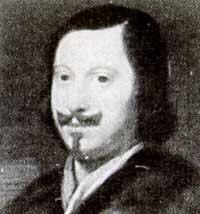Torricelli, Evangelist
(1608-1647)
This Italian physicist entered Faenza on October 15, 1608. As a young man he studied mathematics in Rome. When he first read Galileo's works in 1638 he burst into physics and wrote De Motu (Higiduraz).

Galileo himself also read Torricelli's book and was fascinated by the work of the faenza, until in 1641 he invited Florence to be his secretary. Torricelli passed there, as an assistant to the old blind astronomer, the last three months of Galileo's life.
When Galileo died, he worked as a professor of mathematics at the Academy of Florence and following a suggestion from Galileo, two years later (1644) he invented the mercury barometer.
He did not publish his discovery because he devoted himself fully to the world of mathematics. In geometry he studied the cycloid associated with the topic of curves. It is the curve that describes a point of the wheel circumference when a wheel rotates on a plane.
Torricelli published in 1644 the book Opera Geometrica, in which he published his discoveries on the movement of fluids and projectiles. His geometric theories contributed to the development of integral calculus. Also worked the so-called Torricelli theorem. Its equation calculates the flow of the liquid contained in a container from the hole made at a certain distance below its surface.
But we came to a barometer in which the discovery of Torricelli predominates. In the last days of his life, Galileo tried to demonstrate an idea of Aristotle that emptiness is not in nature, that nature rejects emptiness by itself. Galileo, though revolutionary, was conservative in many respects. However, he did not consider this idea absolute and suggested that Torricelli study it.
Aristotle's idea questioned some mining facts. In the mines, absorption vacuum pumps were used to prevent flooding. Meagizon showed that the pump located more than ten meters above water level, of any size or power, could not extract water.
Torricelli wondered what could happen if the pump had to extract mercury that was 13.5 times heavier instead of water.
In 1644 Torricelli made an essay to demonstrate the idea of Aristotle. It filled with mercury a glass tube of 1.20 meters in length, closed one end and introduced the other end of the tube into a mercury container. Some of the mercury came to the ship, but in the space left at the top of the vertical tube it was empty. Therefore, according to Aristotle, the void in nature did not exist, but it could be created.
Delving into his essay, he observed that the height of the mercury column had changes over time and suggested that it was due to the variation in pressure that the atmosphere affected the mercury in the container. Therefore, he had invented the barometer.
The air of the atmosphere, due to its pressure, had weight, finite weight and therefore, finite height. Years later Pascal showed it and for the first time it could be considered a finite atmosphere in a large, empty universe.
XVII. In the 19th century, the German physicist Otto von Guericke invented a special barometer. A float used the arms above and below a doll and served to predict time. It was the forerunner of the device called a barometer that records the pressure.
Torricelli died in Florence on 25 October 1647.
Buletina
Bidali zure helbide elektronikoa eta jaso asteroko buletina zure sarrera-ontzian











